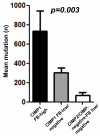Fusobacterium in colonic flora and molecular features of colorectal carcinoma
- PMID: 24385213
- PMCID: PMC4396185
- DOI: 10.1158/0008-5472.CAN-13-1865
Fusobacterium in colonic flora and molecular features of colorectal carcinoma
Abstract
Fusobacterium species are part of the gut microbiome in humans. Recent studies have identified overrepresentation of Fusobacterium in colorectal cancer tissues, but it is not yet clear whether this is pathogenic or simply an epiphenomenon. In this study, we evaluated the relationship between Fusobacterium status and molecular features in colorectal cancers through quantitative real-time PCR in 149 colorectal cancer tissues, 89 adjacent normal appearing mucosae and 72 colonic mucosae from cancer-free individuals. Results were correlated with CpG island methylator phenotype (CIMP) status, microsatellite instability (MSI), and mutations in BRAF, KRAS, TP53, CHD7, and CHD8. Whole-exome capture sequencing data were also available in 11 cases. Fusobacterium was detectable in 111 of 149 (74%) colorectal cancer tissues and heavily enriched in 9% (14/149) of the cases. As expected, Fusobacterium was also detected in normal appearing mucosae from both cancer and cancer-free individuals, but the amount of bacteria was much lower compared with colorectal cancer tissues (a mean of 250-fold lower for Pan-fusobacterium). We found the Fusobacterium-high colorectal cancer group (FB-high) to be associated with CIMP positivity (P = 0.001), TP53 wild-type (P = 0.015), hMLH1 methylation positivity (P = 0.0028), MSI (P = 0.018), and CHD7/8 mutation positivity (P = 0.002). Among the 11 cases where whole-exome sequencing data were available, two that were FB-high cases also had the highest number of somatic mutations (a mean of 736 per case in FB-high vs. 225 per case in all others). Taken together, our findings show that Fusobacterium enrichment is associated with specific molecular subsets of colorectal cancers, offering support for a pathogenic role in colorectal cancer for this gut microbiome component.
©2014 AACR
Figures



References
-
- Signat B, Roques C, Poulet P, Duffaut D. Fusobacterium nucleatum in periodontal health and disease. Curr Issues Mol Biol. 2011;13:25–36. - PubMed
-
- Swidsinski A, Dörffel Y, Loening-Baucke V, et al. Acute appendicitis is characterised by local invasion with Fusobacterium nucleatum/necrophorum. Gut. 2011;60:34–40. - PubMed
-
- Strauss J, Kaplan GG, Beck PL, et al. Invasive potential of gut mucosa-derived Fusobacterium nucleatum positively correlates with IBD status of the host. Inflamm Bowel Dis. 2011;17:1971–1978. - PubMed
-
- Neut C, Bulois P, Desreumaux P, et al. Changes in the bacterial flora of the neoterminal ileum after ileocolonic resection for Crohn’s disease. Am J Gastroenterol. 2002;97:939–946. - PubMed
-
- Ohkusa T, Sato N, Ogihara T, Morita K, Ogawa M, Okayasu I. Fusobacterium varium localized in the colonic mucosa of patients with ulcerative colitis stimulates species-specific antibody. J Gastroenterol Hepatol. 2002;17:849–853. - PubMed
Publication types
MeSH terms
Substances
Grants and funding
LinkOut - more resources
Full Text Sources
Other Literature Sources
Medical
Research Materials
Miscellaneous

